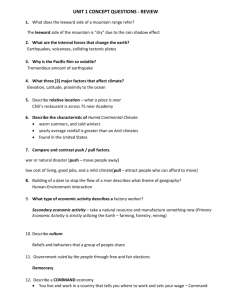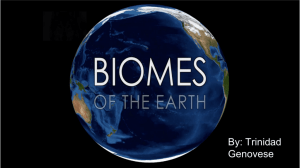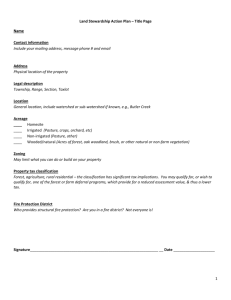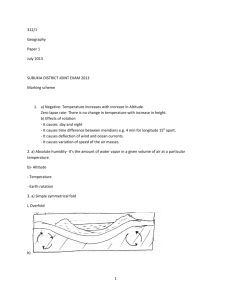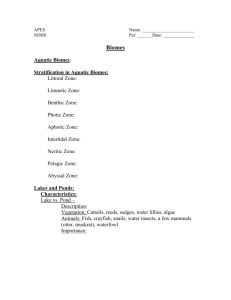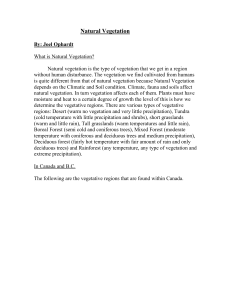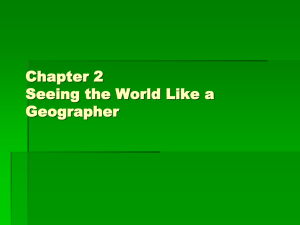Biome-Study-Guide-Answers1
advertisement
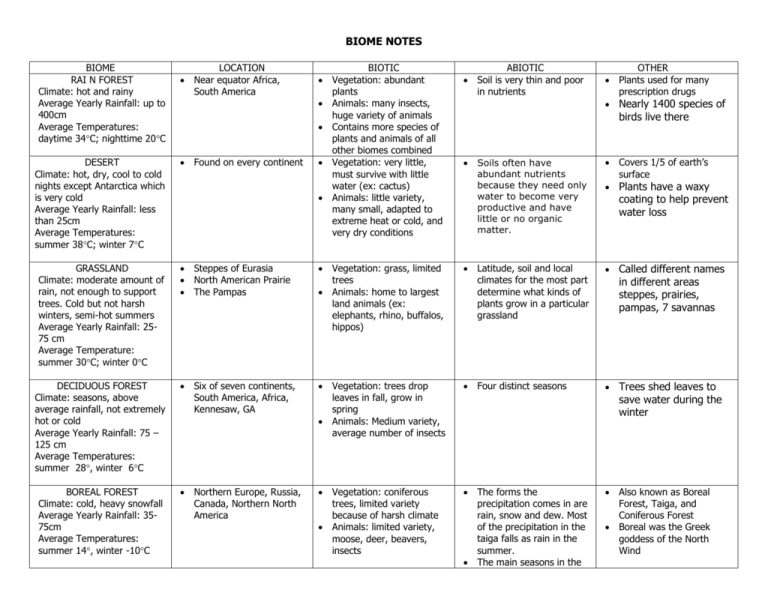
BIOME NOTES BIOME RAI N FOREST Climate: hot and rainy Average Yearly Rainfall: up to 400cm Average Temperatures: daytime 34C; nighttime 20C DESERT Climate: hot, dry, cool to cold nights except Antarctica which is very cold Average Yearly Rainfall: less than 25cm Average Temperatures: summer 38C; winter 7C LOCATION Near equator Africa, South America Found on every continent BIOTIC Vegetation: abundant plants Animals: many insects, huge variety of animals Contains more species of plants and animals of all other biomes combined Vegetation: very little, must survive with little water (ex: cactus) Animals: little variety, many small, adapted to extreme heat or cold, and very dry conditions ABIOTIC Soil is very thin and poor in nutrients OTHER Plants used for many prescription drugs Nearly 1400 species of Soils often have abundant nutrients because they need only water to become very productive and have little or no organic matter. Covers 1/5 of earth’s surface Plants have a waxy birds live there coating to help prevent water loss GRASSLAND Climate: moderate amount of rain, not enough to support trees. Cold but not harsh winters, semi-hot summers Average Yearly Rainfall: 2575 cm Average Temperature: summer 30C; winter 0C Steppes of Eurasia North American Prairie The Pampas Vegetation: grass, limited trees Animals: home to largest land animals (ex: elephants, rhino, buffalos, hippos) Latitude, soil and local climates for the most part determine what kinds of plants grow in a particular grassland Called different names DECIDUOUS FOREST Climate: seasons, above average rainfall, not extremely hot or cold Average Yearly Rainfall: 75 – 125 cm Average Temperatures: summer 28, winter 6C Six of seven continents, South America, Africa, Kennesaw, GA Vegetation: trees drop leaves in fall, grow in spring Animals: Medium variety, average number of insects Four distinct seasons Trees shed leaves to BOREAL FOREST Climate: cold, heavy snowfall Average Yearly Rainfall: 3575cm Average Temperatures: summer 14, winter -10C Northern Europe, Russia, Canada, Northern North America Vegetation: coniferous trees, limited variety because of harsh climate Animals: limited variety, moose, deer, beavers, insects The forms the precipitation comes in are rain, snow and dew. Most of the precipitation in the taiga falls as rain in the summer. The main seasons in the in different areas steppes, prairies, pampas, 7 savannas save water during the winter Also known as Boreal Forest, Taiga, and Coniferous Forest Boreal was the Greek goddess of the North Wind BIOME NOTES Boreal Forest continued TUNDRA Climate: very cold, dry Average Yearly Rainfall: 3050cm Average Temperatures: summer 12C; winter -26C FRESHWATER Warmer near the surface where sunlight reaches the bottom MARINE Surface zone- sunlight heats the top 100m Deep zone- 2*C taiga are winter and summer. The spring and autumn are so short, you hardly know they exist. Extreme north, Arctic Vegetation: few trees, limited plants, moss, lichen, permafrost Animals: caribou, insects in summer, wolves, birds that fly south, polar bear Has permafrost Polar & alpine Ponds and Lakes - bodies of standing or still water Vegetation: algae are major producers Animals: insects, snails, amphibians, fish Catfish are scavengers Bacteria are decomposers in lake or pond Rivers and Streams – both have moving water, headwaters are where rivers and streams begin Vegetation and Animals – adapted for moving water Estuaries – where fresh water of a river meets salt water of the ocean Vegetation and animals – crabs, worms, clams, fish, and algae Deep Zone – home of some bizarre looking animals Intertidal – part of the beach between highest high tide and lowest low tide Neritic – part of ocean that extends over the continental shelf Vegetation and animals – contains many schools of fish, coral reefs, and algae Surface – area of ocean in which light penetrates (a few hundred meters) Vegetation and animals – contains oceans producers which drive all of the other zones Deep Zone – most of water is completely dark Vegetation and animals – feed on animals sinking BIOME NOTES from surface Temperate Rainforest Climate: moderate, lots of rain Northwest United States Vegetation: huge trees Animals: large selection (ex: wolf, deer, bear, elk)
